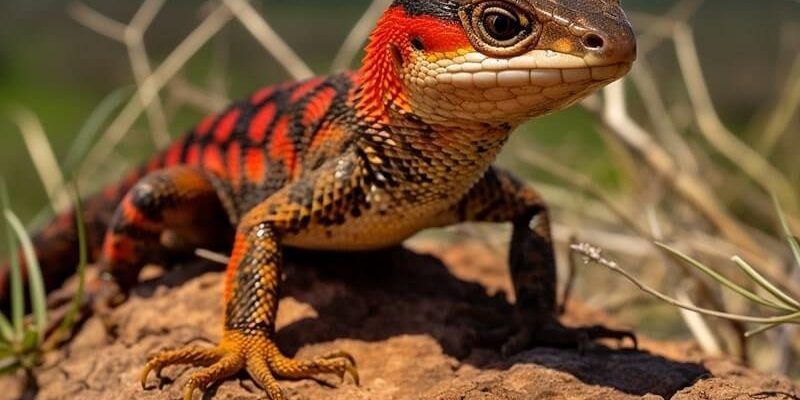![Fire Skink Vs. [Similar Species] - How They Compare](https://gudri.com/wp-content/uploads/2025/06/Fire_Skink_Vs___Similar_Species____How_They_Compare_image_0.jpg)
In this piece, we’ll dive deep into the world of fire skinks and compare them with other skink species. We’ll explore their habitats, behaviors, and unique features. By the end, you’ll have a clearer picture of what makes the fire skink special and how it fits into the greater family of skinks. So let’s get started!
What Is a Fire Skink?
Fire skinks, known scientifically as *Lampornis firense*, hail from the tropical forests of West Africa, particularly around countries like Cameroon and the Democratic Republic of Congo. What sets them apart from other lizards is not just their striking appearance but also their engaging behaviors. Fire skinks are relatively small, growing up to about 12 inches long, and they sport a mesmerizing pattern of bright orange mixed with deep black.
These skinks are primarily ground-dwellers, often seen scuttling through the underbrush. Their vibrant colors serve a dual purpose: they attract mates and ward off potential predators. Here’s the thing—when a fire skink feels threatened, it can quickly dart into the dense foliage, using its speed and agility to escape danger.
Physical Characteristics of Fire Skinks
The physical appearance of fire skinks is one of their most notable traits. Their glossy scales not only make them look good but also help them retain moisture. This is particularly important because they live in humid environments. You might be wondering what else contributes to their stunning look.
– Coloration: The bright orange and black patterns aren’t just for show. They play a role in camouflage among the forest floor’s shadows and light.
– Body Shape: Fire skinks have elongated bodies that help them squeeze through tight spaces. This is especially useful for escaping predators or searching for food.
– Size: While adults usually max out around 12 inches, they grow relatively slowly, reaching maturity around two years.
Understanding these characteristics is essential not only for enthusiasts but also for anyone interested in caring for these fascinating reptiles.
Similar Species: The Common Skink
Now that we’ve covered the fire skink, let’s introduce a similar species: the common skink (*Scincus scincus*). Common skinks are found in various habitats across Europe, Africa, and Asia. Unlike the fire skink, they have a more subdued, muted coloration, often in shades of brown and gray.
What’s fascinating about the common skink is its adaptability. They thrive in various environments, from forests to deserts. Their ability to adapt makes them a resilient species, but it also means they often go unnoticed when compared to the flashy fire skink.
Comparing Habitats and Behaviors
When comparing the fire skink and the common skink, their habitat choices tell an interesting story. Fire skinks prefer warm, humid areas rich in underbrush. They tend to stay low to the ground, hiding among leaves and fallen branches.
On the flip side, common skinks can be found in arid environments as well. This difference in habitat leads to varying behaviors. Fire skinks tend to be more social than common skinks, often seen basking together or interacting.
– Fire Skinks: Social, enjoy humid environments, often display bold colors.
– Common Skinks: More solitary, adaptable to various habitats, less colorful.
Understanding these behavioral differences can help you appreciate the ecological roles each species plays in their respective environments.
Dietary Needs and Feeding Habits
You might be wondering what these skinks eat. Fire skinks are primarily insectivorous, which means they mainly feed on bugs. Their diet includes a variety of insects, worms, and even small snails. This diet helps them maintain their bright colors, as the nutrients from their prey contribute to their vibrant appearance.
Common skinks, while also insectivorous, have a broader range of dietary options. They can consume fruits and plant matter in addition to insects. This flexibility allows them to thrive in different environments where food sources can vary greatly.
– Fire Skinks: Prefer live insects; active foragers.
– Common Skinks: More varied diet; opportunistic feeders.
It’s essential to know these distinctions if you plan on keeping either of these species as pets.
Care Requirements for Pet Skinks
If you’re thinking about keeping a fire skink or a similar species as a pet, it’s crucial to understand their care requirements. Fire skinks thrive in warm and humid environments, so a terrarium with proper heating and humidity levels is essential. They enjoy a mix of hiding spots and open areas for basking.
Conversely, common skinks are a bit more forgiving when it comes to habitat. They can adapt to various conditions, but they still require enough space to roam and explore. Here are some basic care tips for both:
- Temperature
- Humidity: Maintain a humidity level of around 60% for fire skinks.
- Diet: Offer a variety of insects and, for common skinks, some plant matter.
- Space: Ensure a spacious habitat with hiding spots.
By meeting these needs, you’ll create a comfortable environment that allows these skinks to thrive.
In the battle of the fire skink vs. other skinks, it’s clear that each species has its unique charm and appeal. The fire skink, with its bold colors and engaging behaviors, certainly catches the eye. However, the adaptability and understated beauty of the common skink also deserve recognition.
Whether you’re a budding reptile keeper or simply someone fascinated by these remarkable creatures, understanding their differences can help you appreciate them more. So the next time you see a fire skink, remember the world of skinks is much broader and more diverse than it may first appear. Happy herping!

